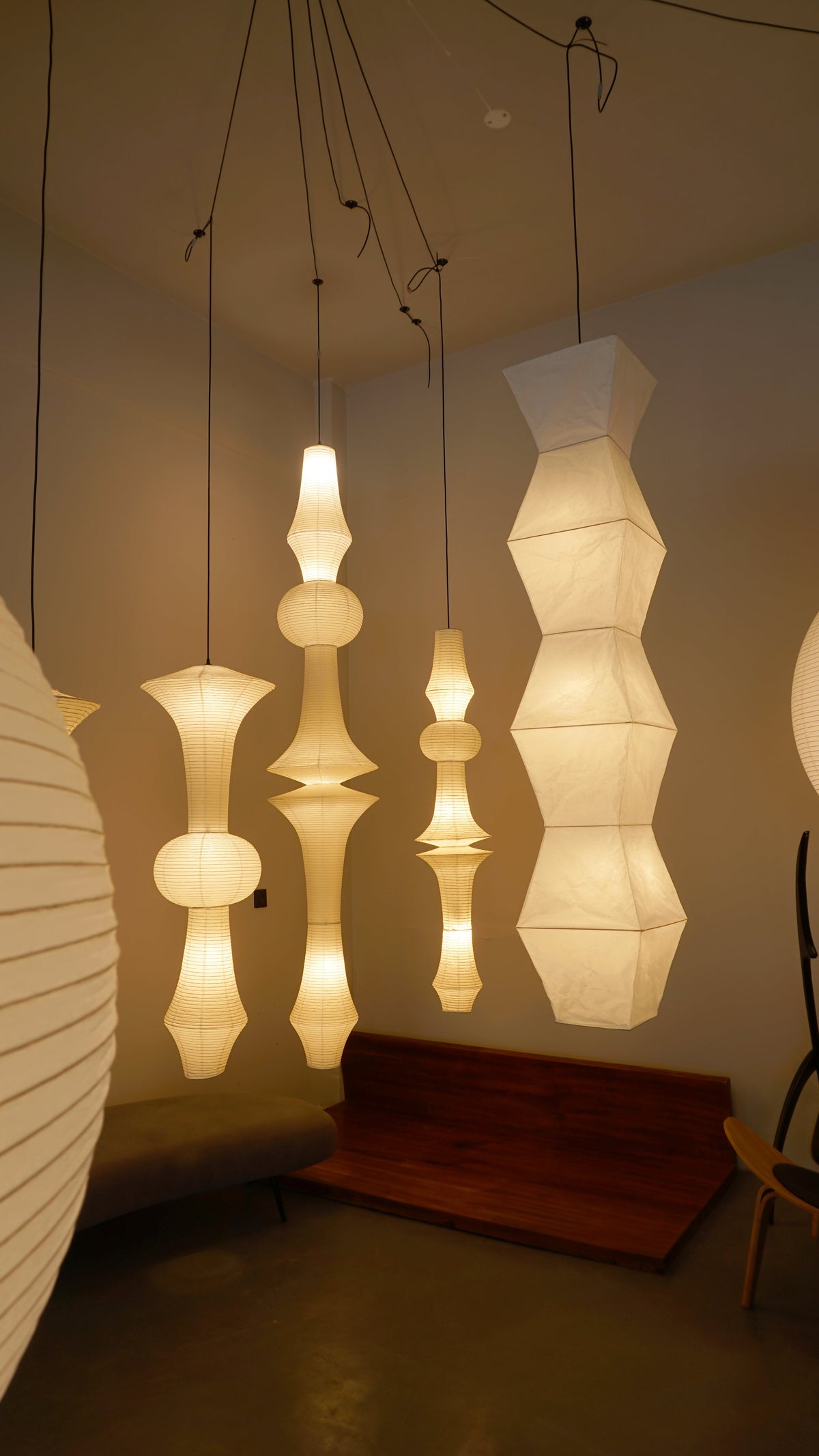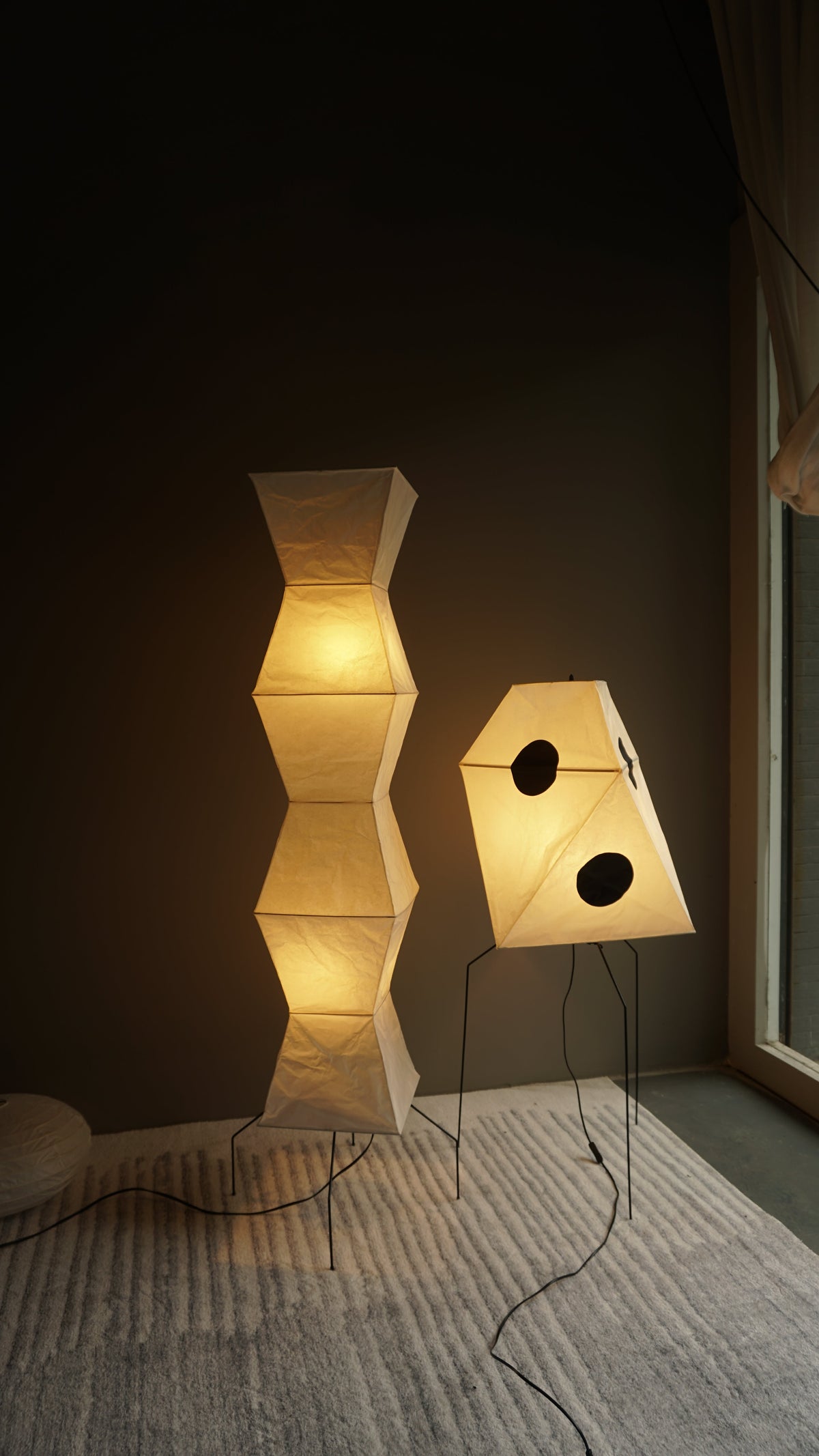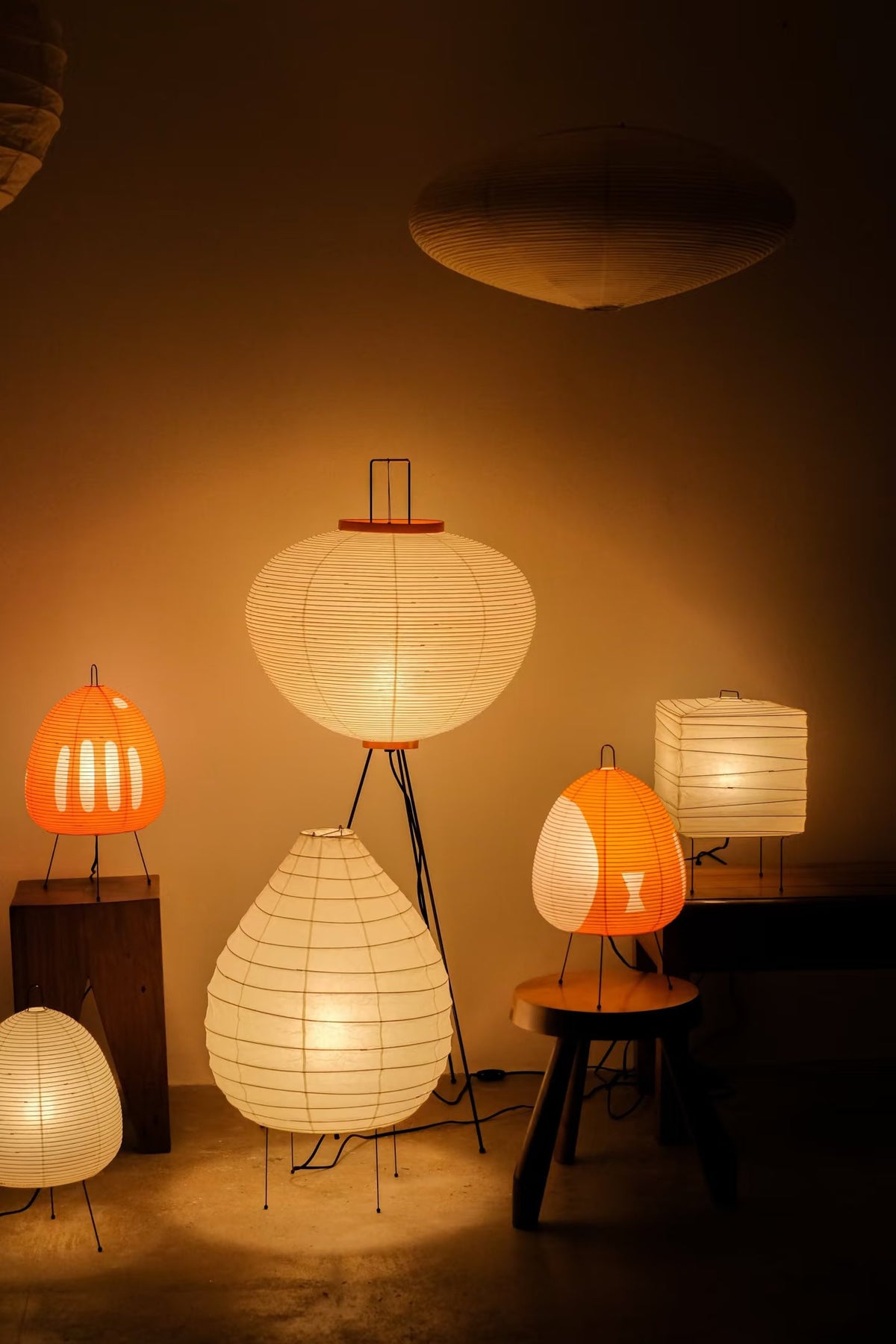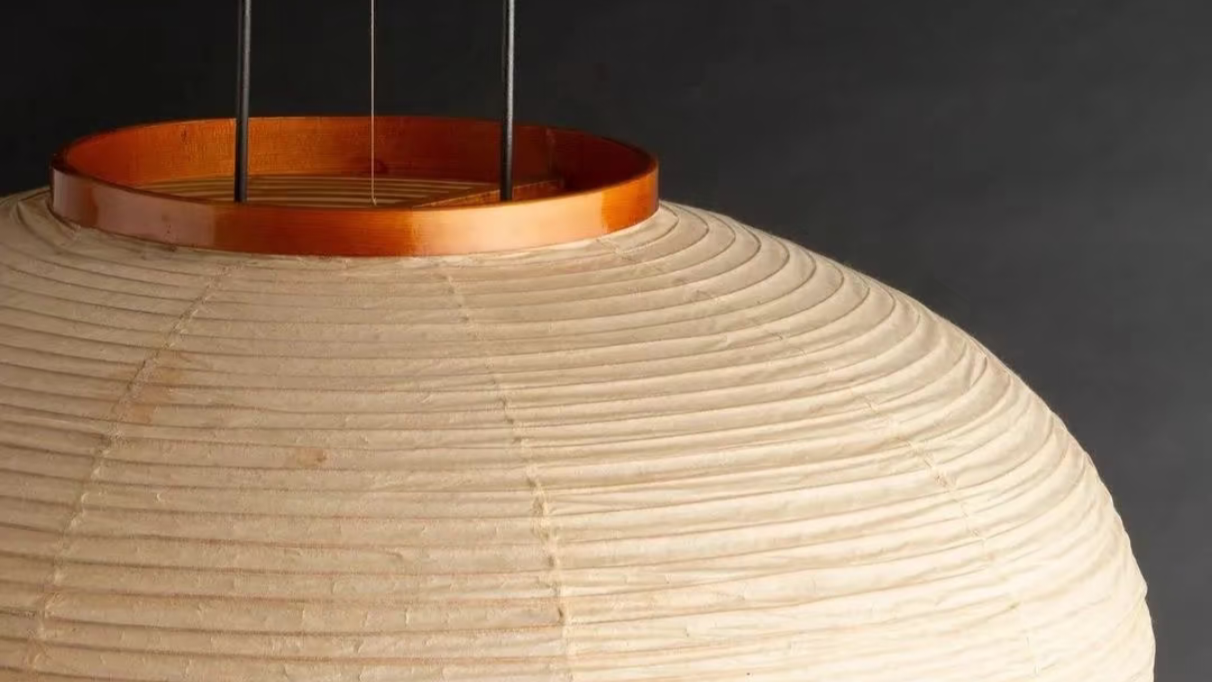Light has two jobs: it lets us see, and it makes a room feel a certain way. When you’re shopping for bulbs — or deciding how to light a dark living room — two label terms you'll see are soft white and warm white. They’re commonly used by retailers, but what do they mean, how do they differ, and how should that affect the bulb you buy for your akari lamp, akari floor lamp, or pendant?
This guide breaks it down simply, gives practical rules you can use today, and includes Akari-friendly tips if you own or plan to buy a noguchi akari lamp or an akari paper lamp.
1) Soft white vs warm white — the short answer
-
Soft white usually describes a color temperature around 2700K. It looks like classic incandescent light — amber, cozy, relaxing.
-
Warm white typically sits around 3000K. It’s still warm, but slightly brighter and less amber than soft white.
-
Important: naming isn’t standardized — sometimes brands call 2700K “warm white” and 3000K “soft white.” Always check the Kelvin (K) number on the bulb.
Think of it this way: soft = how the light feels/edges (soft shadows) while warm = color of the light. But in retail language, both terms mostly refer to color temperature, so look for the Kelvin number first.
2) Why Kelvin (K), lumens and CRI matter more than words
When choosing bulbs, focus on three specs:
-
Kelvin (K) — color temperature.
-
2700K = very warm (best for cozy evening living rooms and bedrooms).
-
3000K = warm white (a touch brighter; good for kitchens and more active rooms).
-
3500K+ = neutral to cool (better for work or task lighting).
-
-
Lumens — brightness. Don’t shop by watts. For a single living-room lamp, aim for 1200–2000 lumens total from all fixtures; for bright dark rooms you may need 2000–4000 lumens overall.
-
CRI (Color Rendering Index) — how natural colors appear under a bulb. CRI 90+ is excellent; Ra ≥ 95 is near-sunlight quality. For food, art, and textiles — aim high.
A bulb labeled “soft white” at 2700K with 800 lumens and CRI 95 will feel different from a “warm white” 3000K bulb at 800 lumens and CRI 80. Look at numbers, not marketing.
3) Soft white vs warm white — practical room rules
Living room / lounge (cozy, social)
-
Choose 2700K–3000K.
-
Use soft white (2700K) in lamps aimed at relaxation (Akari floor lamp beside a sofa).
-
Add a tunable 3000K option near task areas (reading arm or floor torchiere).
-
Aim for 1500–3000 lumens total for a medium room.
Bedroom (restful)
-
Prefer 2700K (soft white) for bedside Akari paper lamps and dimmable overheads.
-
Keep CRI ≥ 90 if you care about how clothes look.
Kitchen / workspace (clear & bright)
-
Use 3000K–3500K for clarity; combine overheads with task under-cabinet lighting.
-
Higher lumens (3000+ total) help in very dark kitchens.
Dark rooms (where you need “bright lamps for dark rooms”)
-
Layer lighting: an uplight torchiere or ceiling LED + task lamps + one or two ambient fixtures (like an akari pendant lamp).
-
For overall brightness, use higher-lumen fixtures and keep Kelvin in the 3000K range for clarity; use 2700K accents for mood.
4) What soft white vs warm white means for Akari and paper lamps
Akari-style paper lamps (inspired by Noguchi) and other Japanese lamp designs use translucent washi-like shades to soften and spread light. That affects bulb choice:
-
Soft white (2700K) is excellent for Akari paper lamps when your goal is mood and comfort. The paper deepens the amber glow and creates beautiful, even diffusion and gentle shadows. Perfect for living rooms, reading nooks, and bedrooms.
-
Warm white (3000K) works when you want slightly more visual clarity while preserving warmth — good for dining areas or kitchen islands when Akari-style pendants are mixed with task lights.
-
Important: Paper lamps diffuse light strongly — a 2700K bulb behind washi can feel warmer than the same bulb in a bare fixture. If you want more perceived brightness without losing warmth, choose a higher-lumen bulb (not a higher Kelvin).
5) Bulb recommendations (exact picks and types)
-
Best cozy, soft glow for Akari-style lamp: LED frosted globe, 2700K, 800–1200 lm, CRI 90+. Example: 2700K LED A19 frosted, CRI 90+.
-
Best bright but warm for dark rooms: LED A21 or BR30, 3000K, 1600–2600 lm, CRI 90+ (use in uplights or recessed cans).
-
Best for reading task near Akari: small directional LED (GU10 or PAR16) 3000K, 600–1000 lm, CRI 90+.
-
If you want tunable convenience: pick a tunable white (2700–5000K) with a good dimmer; set to 2700K in evenings, 3000–3500K for tasks.
Glass vs filament look? Filament-style LEDs give a vintage look behind paper shades; frosted bulbs give the most even diffusion.
6) Dimming, flicker, and eye comfort
-
Use dimmable LED bulbs and a compatible dimmer (LED rated). Dim to 20–40% for relaxed evenings.
-
Choose no-flicker bulbs (many cheap LEDs have flicker at low dim levels). Look for “flicker-free” or read reviews.
-
For Akari and paper lamps, avoid bulbs that get very hot — use LEDs with low heat to protect the paper.
7) Bright lamps for dark rooms — setups that work
If your room is dark, here are reliable setups that balance brightness and comfort:
Setup A — Single-room refresh (living room ~200–300 sq ft):
-
Torchiere uplight with 2000 lm LED (3000K) — main ambient.
-
Akari floor lamp (2700K, 800–1200 lm) — accent + soft glow.
-
Reading task lamp (adjustable, 400–800 lm, 3000K).
Setup B — Dining focus:
-
Large Akari pendant (3000K, 1500 lm effective through shade) centered over table.
-
Recessed dimmable can lights (3000K) on zone dimmer for pre/post-meal tasks.
Setup C — Minimal, small room:
-
One bright multi-head floor lamp (total 2000+ lm) + one Akari table lamp for mood.
8) Soft white vs warm white — quick shopping checklist
-
Check Kelvin: 2700K = soft/warmest; 3000K = warm/neutral.
-
Check lumens: match the task and room size (1500–3000 lm typical for living rooms).
-
Check CRI: aim for 90+.
-
Check dimmability and compatibility with your dimmer.
-
For paper lamps (Akari-style), pick frosted or filament LED with low heat and good CRI.
-
If uncertain, buy one tunable bulb and test in your shade before replacing multiple bulbs.
9) FAQs (fast)
Q: Will a 3000K bulb look bad in a paper shade?
A: Not at all — 3000K behind washi looks warm and slightly brighter than 2700K. It’s a solid compromise for dining and living areas.
Q: I want “soft warm” and “bright” — what then?
A: Keep color at 2700–3000K, boost the lumens (or add more fixtures). Large pendants + an uplight or torchiere is an effective combo.
Q: Do Akari lamps need special bulbs?
A: Use low-heat LEDs, good CRI, and frosted or filament types for best diffusion. Avoid high-heat halogen bulbs.
10) Final thought — the best glow is the one you like
At the end of the day, soft white vs warm white is a choice about mood and function. If you want cozy evenings, lean to 2700K soft white. If you want slightly brighter, clearer light while keeping comfort, pick 3000K warm white. For dark rooms, add bright ambient sources (torchieres/recessed/LED uplights) and keep Akari-style lamps for the soft, human touch.
Want quick help choosing bulbs for your specific room? Tell me your room size and what fixtures you're using (Akari pendant, floor lamp, torchiere), and I’ll give a tailored bulb list (Kelvin, lumens, CRI) you can buy today.




0 commentaire